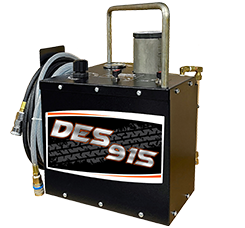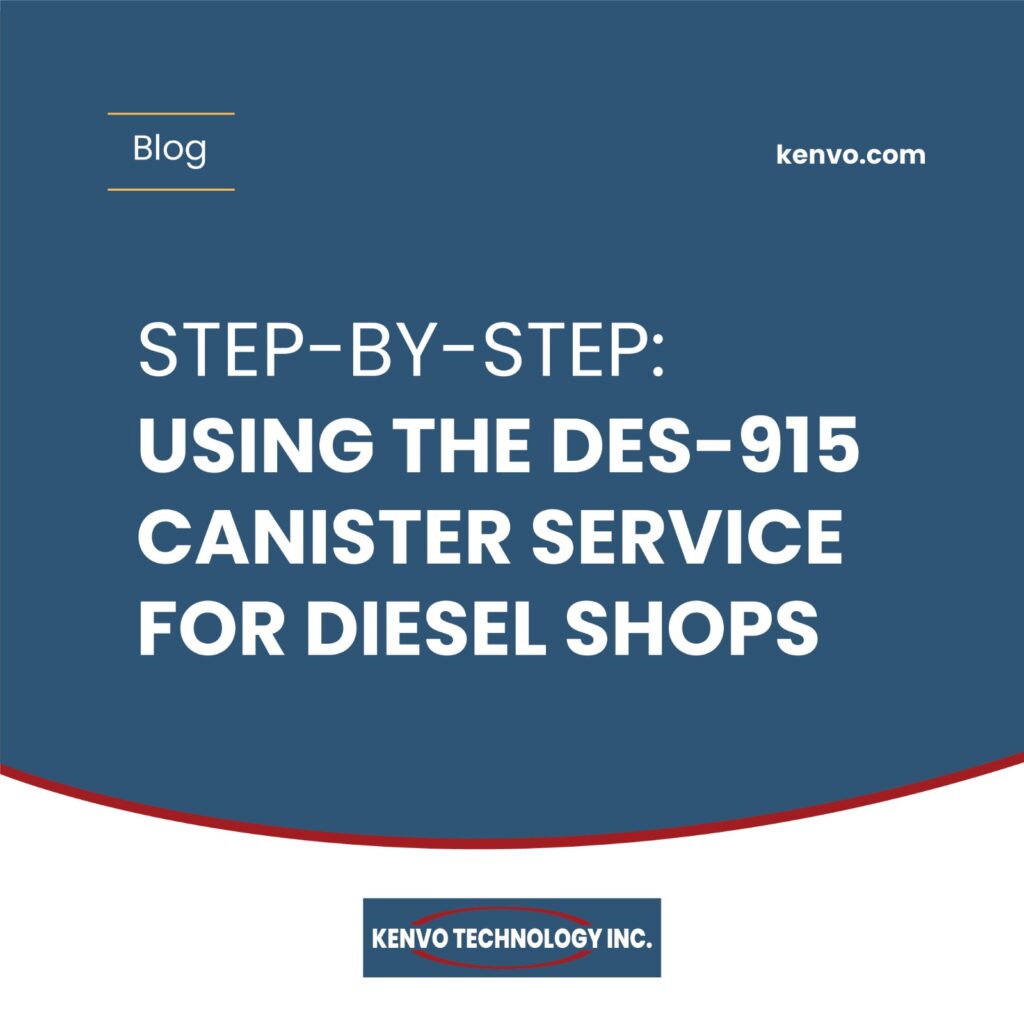Diesel engines are workhorses, but like any high-performance system, they need proper care to stay reliable. One of the most effective ways to maintain their efficiency is through professional fluid and emissions servicing—specifically using the DES-915 diesel canister service. Designed for precision, durability, and compliance, the DES-915 helps diesel shops keep engines running cleaner, smoother, and longer.
In this guide, we’ll cover everything from setting up the DES-915 to best practices for shop safety, maintenance schedules, and how to stay ahead of emissions regulations. Whether you’re a shop owner, technician, or fleet maintenance manager, this walkthrough will help you get the most from your diesel service operations.

Why the DES-915 is a Game-Changer for Diesel Shops
The DES-915 diesel canister service system is designed to simplify and optimize diesel engine maintenance. It integrates with shop workflows, improves turnaround times, and ensures customers’ vehicles meet environmental standards. This system isn’t just about flushing contaminants—it’s about extending engine life, improving fuel economy, and reducing costly repairs.
By investing in professional-grade equipment like the DES-915, diesel shops can stand out from competitors, offer premium services, and build customer trust. This machine supports not only diesel EGR fuel cleaning but also works in tandem with other specialized tools, such as brake flush machines, automatic transmission fluid exchangers, radiator coolant machines, and power steering flush systems, to give clients a comprehensive vehicle care solution.
Step 1: Preparing for the Service
Before starting a DES-915 service, preparation is key. This step ensures both safety and efficiency, preventing mistakes that could damage the engine or equipment. Technicians should always inspect the workspace, confirm that the machine is in proper working condition, and gather all necessary attachments and fluids.
Check the Work Area for Safety
Always ensure the service bay is clean, well-lit, and free from any loose objects that could interfere with the job. Diesel engines often involve high temperatures, fuel vapors, and moving components, so having a clutter-free environment reduces risks. Proper ventilation is essential, especially when working with exhaust gas recirculation systems, as harmful gases can accumulate in enclosed spaces.
Inspect the DES-915 Machine
A quick inspection before each use helps avoid unexpected breakdowns during the service. Check hoses for cracks, fittings for leaks, and ensure the gauges and control panel are functioning. The DES-915 is built for durability, but like brake fluid exchange machines and coolant flush machines, it needs regular inspection to operate at peak performance.
Gather Required Tools and Fluids
Using the correct cleaning agents and additives is critical for achieving a thorough diesel service. Stock up on high-quality diesel fuel treatments that comply with manufacturer recommendations. Technicians should also have their personal protective equipment (PPE) ready, including gloves, goggles, and hearing protection for noisy environments.
Step 2: Connecting the DES-915 to the Diesel Engine
Correctly connecting the DES-915 is crucial to ensure a secure and leak-free setup. This step directly impacts the effectiveness of the cleaning process and the safety of both the technician and the vehicle.
Identify the Service Ports
Locate the appropriate connection points on the vehicle’s diesel system. The exact location may vary depending on the engine design, but generally involves points in the diesel EGR fuel system where contaminants accumulate. Familiarity with the vehicle’s service manual helps prevent incorrect hookups that could damage components.
Attach the Service Hoses Securely
The DES-915 comes with heavy-duty hoses and connectors designed to handle diesel pressures. Ensure they are tightly fastened to prevent leaks, which could create both safety hazards and environmental concerns. This is just as important as when hooking up a power steering fluid exchanger machine or a brake flush machine—secure connections mean safer, more efficient service.
Prime the Machine for Operation
Before starting the cleaning cycle, prime the DES-915 with the chosen cleaning solution. This ensures that the system delivers an even and consistent flow of the additive into the engine, maximizing the cleaning effect and reducing wasted product.
Step 3: Running the Cleaning Cycle
The cleaning cycle is where the DES-915 does its magic, flushing out carbon deposits, fuel contaminants, and other buildup from the diesel system.
Set the Recommended Pressure and Flow Rates
Different engines may require specific settings for optimal cleaning. Consult the manufacturer’s guidelines to ensure you’re operating at the correct pressure. This is like setting correct flow rates in an automatic transmission fluid exchange machine—precision ensures performance.
Monitor the Process Carefully
During operation, keep an eye on the machine’s gauges and listen for unusual noises. Any irregularities could indicate a blockage, leak, or incorrect connection. Continuous monitoring helps prevent costly engine damage and ensures a consistent clean.
Allow the Full Cycle to Complete
Don’t cut corners by stopping the process early. The DES-915 is calibrated to complete its cycle in a way that ensures contaminants are fully removed. Skipping this step reduces the effectiveness of the service and shortens the time until the next required cleaning.
Step 4: Post-Service Inspection and Maintenance
Once the cleaning cycle is complete, post-service checks are essential to ensure the vehicle is in top shape and the DES-915 is ready for the next job.
Check Engine Performance
Visit here to start the engine and observe its performance. Listen for smoother operation, check idle stability, and ensure there are no warning lights. Just as with a radiator coolant flush machine service, improved performance is the goal.
Inspect for Leaks or Residue
Carefully inspect all connection points for any remaining fuel residue or leaks. Promptly clean up any spills, as diesel fuel can damage paint and create slip hazards in the shop.
Clean and Store the DES-915
Rinse the internal lines of the DES-915 with clean fluid to prevent buildup. Coil hoses neatly and store the unit in a dry, safe place. Proper care extends the life of the machine, just like with a brake fluid flush machine or power steering flush system.
Best Practices for Using the DES-915 Diesel Canister Service
Following best practices ensures consistent results and customer satisfaction.
Maintain a Regular Service Schedule
For fleet vehicles and high-mileage diesel engines, schedule DES-915 cleanings at manufacturer-recommended intervals. Pairing this with regular services using other shop tools like automatic transmission fluid exchangers and coolant flush machines maximizes overall vehicle longevity.
Train All Technicians Thoroughly
Improper use of the DES-915 can damage both the machine and the vehicle. Ensure all staff are trained not only on the equipment but also on diesel engine basics, emissions compliance, and shop safety procedures.
Document Each Service for Customer Records
Keeping detailed service logs builds trust with clients and helps track maintenance history. Include the type of additive used, service date, and any post-service recommendations for future care.
Conclusion
The DES-915 diesel canister service machine is more than just a tool—it’s a performance enhancer for both the vehicle and your shop’s reputation. By mastering its use and combining it with other specialized tools like brake flush machines, power steering fluid exchangers, and coolant flush systems, shops can deliver comprehensive, high-quality maintenance services that keep diesel engines running at their best.
Investing in equipment like the DES-915 not only boosts operational efficiency but also positions your shop as a trusted, professional service provider in an increasingly competitive market.

